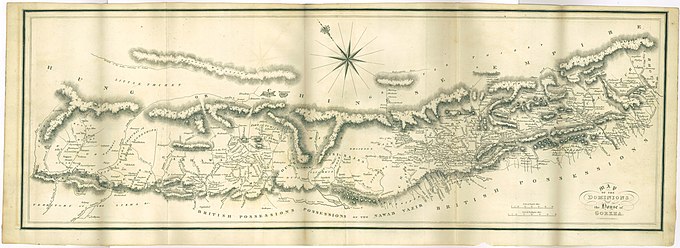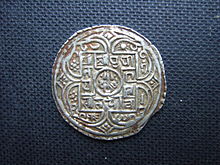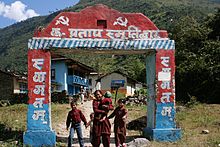History of Nepal
Classical Indian sources mention Nepal, and Nepali stories delve into mythology, religion, and culture rather than providing a clear historical account.
[2] The derivation of the word Nepal is a subject of various theories: Prehistoric sites of palaeolithic, mesolithic and neolithic origins have been discovered in the Siwalik hills of Dang district.
[27] By means of the notices contained in the classics of the East and West, the Kiranti people were living in their present whereabouts for the last 2000 to 2500 years, with an extensive dominion, possibly reaching at one time to the delta of the Ganges.
"Samudragupta, whose formidable rule was propitiated with the payment of all tributes, execution of orders and visits (to his court) for obeisance by such frontier rulers as those of Samataṭa, Ḍavāka, Kāmarūpa, Nēpāla, and Kartṛipura, and, by the Mālavas, Ārjunāyanas, Yaudhēyas, Mādrakas, Ābhīras, Prārjunas, Sanakānīkas, Kākas, Kharaparikas and other nations"The kings of the Lichhavi dynasty (originally from Vaishali in modern-day India) ruled what is the Kathmandu valley in modern-day Nepal after the Kirats.
[citation needed] Gunakama Deva, who ruled from 949 to 994 CE, commissioned the construction of a big wooden shelter, built from the wood of a single tree, called Kasthamandapa.
He built the Laksmi Vihara and introduced the tradition of worshiping the Kumari; young prepubescent girls believed to be manifestations of the divine female energy or devi.
After the victory in Kirtipur, King Jaya Prakash Malla of Kathmandu sought help from the British and the then East India Company sent a contingent of soldiers under Captain Kinloch in 1767.
The four noble families involved largely in the active politics of the kingdom were the Shah rulers, the Thapas, the Basnyats, and the Pandes before the rise of the Rana dynasty.
[36] From beginning to the mid of 18th century, the Thapas and Pandes had extreme dominance over Nepalese Darbar politics alternatively contesting for central power amongst each other.
This policy helped Nepal maintain its independence during the British colonial era, but it also impeded the country's economic development and modernisation.
In addition to military support, Nepal contributed guns, equipment as well as hundreds of thousand of pounds of tea, sugar and raw materials such as timber to the Allied war effort.
The political parties such as the Praja Parishad and Nepali Congress were already formed in exile by leaders such as B. P. Koirala, Ganesh Man Singh, Subarna Sumsher Rana, Krishna Prasad Bhattarai, Girija Prasad Koirala, and many other patriotic-minded Nepalis who urged the military and popular political movement in Nepal to overthrow the autocratic Rana regime.
Among the prominent martyrs to die for the cause, executed at the hands of the Ranas, were Dharma Bhakta Mathema, Shukraraj Shastri, Gangalal Shrestha, and Dasharath Chand who were the members of the Praja Parisad.
This turmoil culminated in King Tribhuvan, a direct descendant of Prithvi Narayan Shah, fleeing from his "palace prison" in 1950, to India, touching off an armed revolt against the Rana administration.
This eventually ended in the return of the Shah family to power and the appointment of a non-Rana as prime minister following a tri-partite agreement signed called 'Delhi Compromise'.
The new constitution established a "partyless" Panchayat system which King Mahendra considered to be a democratic form of government, closer to Nepalese traditions.
One-state-one-language became the national policy in an effort to carry out state unification, uniting various ethnic and regional groups into a singular Nepali nationalist bond.
The Nepali Congress with the support of the United Left Front decided to launch a decisive agitational movement, the Jana Andolan, which forced the monarchy to accept constitutional reforms and to establish a multiparty parliament.
In 1992, in a situation of economic crisis and chaos, with spiraling prices as a result of the implementation of changes in policy of the new Congress government, the radical left stepped up their political agitation.
Led by Dr. Baburam Bhattarai and Pushpa Kamal Dahal (also known as "Prachanda"), the insurgency began in five districts in Nepal: Rolpa, Rukum, Jajarkot, Gorkha, and Sindhuli.
On 1 June 2001, Prince Dipendra, went on a shooting-spree, assassinating 9 members of the royal family, including King Birendra and Queen Aishwarya, before shooting himself.
In addition to coercive measures, the guerrillas are gaining a foothold because of their popularity with large sectors of Nepalese society, particularly women, untouchables and ethnic minorities.
On 1 February 2005, King Gyanendra dismissed the entire government and assumed full executive powers, declaring a state of emergency to quash the revolution.
Similarly, the Constituent Assembly elected Pushpa Kamal Dahal (Prachanda) of the Unified Communist Party of Nepal (Maoist) as the first Prime Minister of the republic on 15 August 2008, favoring him over Sher Bahadur Deuba of the Nepali Congress.
[54] In response to the Madhesi protests, India suspended vital supplies to landlocked Nepal, citing insecurity and violence in border areas.
[55] The then prime minister of Nepal, KP Sharma Oli, publicly accused India for the blockade calling the act more inhumane than war.
[58] The then United Nations Secretary-General, Ban Ki-moon, alleged that the denial of petroleum and medicine to Nepal constituted a violation of human rights, adding to the humanitarian crisis.
[61] The alliance of communists won the election, and UML leader Khadga Prasad Sharma Oli was sworn in February 2018 as the new Prime Minister.
[62] In March 2018, President Bidya Devi Bhandari, the candidate of the then-ruling Left alliance of the CPN-UML and CPN (Maoist Centre), was re-elected for a second term.
[64] In December 2022, former Maoist guerilla chief, Pushpa Kamal Dahal aka Prachanda, became Nepal's new prime minister after the general election.





